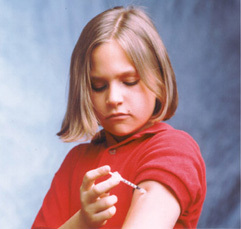Diabetes in children
Reviewed by Dr Stephen Greene, consultant paediatrician, Professor Ian Campbell, consultant physician and Dr Soon Song, consultant physician| The last 30 years has seen a rise in childhood diabetes. |
It is caused by the inability of the pancreas to produce insulin.
Type 1 diabetes is classified as an autoimmune disease, meaning a condition in which the body's immune system 'attacks' one of the body's own tissues or organs.
In Type 1 diabetes it's the insulin-producing cells in the pancreas that are destroyed.
How common is it?
Childhood diabetes isn't common, but there are marked variations around the world:- in England and Wales 17 children per 100,000 develop diabetes each year
- in Scotland the figure is 25 per 100,000
- in Finland it's 43 per 100,000
- in Japan it's 3 per 100,000.
In Europe and America, Type 2 diabetes has been seen for the first time in young people. This is probably in part caused by the increasing trend towards obesity in our society.
But obesity doesn't explain the increase in the numbers of Type 1 diabetes in children - who make up the majority of new cases.
What causes childhood diabetes?
As with adults, the cause of childhood diabetes is not understood. It probably involves a combination of genes and environmental triggers.The majority of children who develop Type 1 don't have a family history of diabetes.
What are the symptoms?
The main symptoms are the same as in adults. They tend to come on over a few weeks:- thirst
- weight loss
- tiredness
- frequent urination.
- tummy pains
- headaches
- behaviour problems.
Doctors should consider the possibility of diabetes in any child who has an otherwise unexplained history of illness or tummy pains for a few weeks.
If diabetes is diagnosed, your child should be referred to the regional specialist in childhood diabetes.
How is diabetes treated in children?
The specialised nature of managing childhood diabetes means that most children are cared for by the hospital rather than by their GP.Most children with diabetes need insulin treatment. If this is the case, your child will need an individual insulin routine, which will be planned with the diabetes team.
- Most now use frequent daily dosage regimes of fast-acting insulin during the day and slow-acting insulin at night.
- Very small children normally don't need an injection at night, but will need one as they grow older.
- Increasing numbers of older children use continuous insulin pumps.
As well as insulin treatment, good glucose control and avoidance of ‘hypos’ (low blood glucose attacks) is important. This is because many of the complications of diabetes increase with the length of time diabetes has been present.
What can parents do?
Living with diabetes can put families under considerable strain, so access to backup support is crucial. This may be from your GP, the hospital team or social services.Understanding all the different aspects of diabetes and its treatment requires patience, but will benefit your child and family life.
The diabetes team at the hospital can help you with the list below.
- Learn how to administer insulin injections. Insulin is usually injected into the skin over the abdomen or the thighs.
- Know the symptoms of low blood glucose and diabetic acidosis and what to do about them.
- Make sure glucose is always available.
- Measure blood glucose levels and teach your child how to do this as soon as they are old enough.
- Teach your child how to self-administer insulin injections as soon as they are old enough - around the age of nine is typical.
- See the doctor on a regular basis, and particularly if your child becomes ill for any reason - treatment is likely to need adjusting.
- Inform the school and friends about the symptoms of low blood glucose and what to do about them.
- Contact your local diabetes association for help and support.
Diet
Diet guidelines
Current recommendations for children with diabetes:
- three main meals
- two to three snacks
- the whole family eats the same meals.
It's important to give your child a healthy balanced diet that is high in fibre and carbohydrates.
A healthy diet is the same for everyone, whether or not they have diabetes.
How much your child should eat depends on age and weight. The dietician and parents should determine this together.
Sweets are no longer off limits because the 'diabetic diet' is now a relic of the past.
Once your child gets to know how her body responds to eating and taking insulin, sweets in moderation are possible - accompanied by the appropriate dose of insulin.
Physical activity
Physical activity is important for children with diabetes, who should try to exercise every day.Physical activity lowers the blood sugar level, so if your child takes insulin, she may need to reduce the dose.
This is because a combination of too much insulin and exercise can lower the blood sugar level and lead to hypos. To counter this, your child should always carry sugar.
Physical activity also affects how much your child can eat. Before your child exercises or plays sport, give extra bread, juice or other carbohydrates.
In the long term
A child who develops diabetes will live with the condition longer than someone who develops diabetes in adulthood.The longer diabetes is present, the higher the risk of long-term complications such as those affecting the eyes and kidneys.
These can start after puberty, but are usually a concern only in later life.
Regular checkups for late-stage complications begin around the age of nine. From then on, this checkup is done every year.


No comments:
Post a Comment